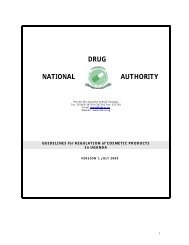guidelines on variations to a registered pharmaceutical product
guidelines on variations to a registered pharmaceutical product
guidelines on variations to a registered pharmaceutical product
- No tags were found...
You also want an ePaper? Increase the reach of your titles
YUMPU automatically turns print PDFs into web optimized ePapers that Google loves.
Guidelines <strong>on</strong> Variati<strong>on</strong>s <strong>to</strong> a Registered Pharmaceutical ProductDocumentati<strong>on</strong> required1. A declarati<strong>on</strong> from the supplier of the FPP that the route of synthesis, quality c<strong>on</strong>trol procedures andspecificati<strong>on</strong>s of the API and key (ultimate) intermediate in the manufacturing process of the API (ifapplicable) are the same as those already accepted.2. Name, address, and resp<strong>on</strong>sibility of the proposed <strong>product</strong>i<strong>on</strong> site or facility involved in manufacturingand/or testing (including block(s) and unit(s). A valid manufacturing and/or testing authorizati<strong>on</strong> and acertificate of GMP compliance, if available.3. Descripti<strong>on</strong> of the batches, copies of certificates of analysis and batch analysis data (in a comparativetabular format) for at least two (minimum pilot scale) batches of the API from the currently acceptedand proposed units/blocks.4. A summary of differences between manufacture and c<strong>on</strong>trol of the API at the currently accepted andproposed units/blocksDescripti<strong>on</strong> of changeC<strong>on</strong>diti<strong>on</strong>s <strong>to</strong> befulfilledDocumentati<strong>on</strong><strong>to</strong> be suppliedReportingtype12a change in the manufacturing process of the 1-3 1-2, 8 AN12bactive <strong>pharmaceutical</strong> ingredient1-2, 4, 6-9 3-4, 11-12 IN12c 1-2, 4-7 3-4, 11-12 Vmin12d N<strong>on</strong>e 2-14 VmajC<strong>on</strong>diti<strong>on</strong>s <strong>to</strong> be fulfilled1. No change in the physical state (e.g. crystalline, amorphous) of the API.2. For low solubility APIs, there is no change in the polymorphic form and whenever particle size is critical(including low solubility APIs) there is no significant change in the particle size distributi<strong>on</strong> compared<strong>to</strong> the API lot used in the preparati<strong>on</strong> of the biobatch.3. API manufacturing site is currently accepted through the WHO PQP APIMF procedure.4. Where materials of human or animal origin are used in the process, the manufacturer does not use anynew process for which assessment of viral safety data or TSE risk assessment is required.5. No change in the route of synthesis (i.e. intermediates remain the same) and there are no newreagents, catalysts or solvents used in the process.6. No change in qualitative and quantitative impurity profile or in physicochemical properties of the API.7. The change does not affect the sterilizati<strong>on</strong> procedures of a sterile API.8. The change involves <strong>on</strong>ly steps before the final intermediate.9. The change does not require revisi<strong>on</strong> of the starting material, intermediate or API specificati<strong>on</strong>sDoc. No.: DAR/GDL/005 Revisi<strong>on</strong> Date: 8 th July 2013 Review Due Date: 16 th July 2016Revisi<strong>on</strong> No.: 1 Effective Date : 16 th July 2013 Page 21 of 70
















